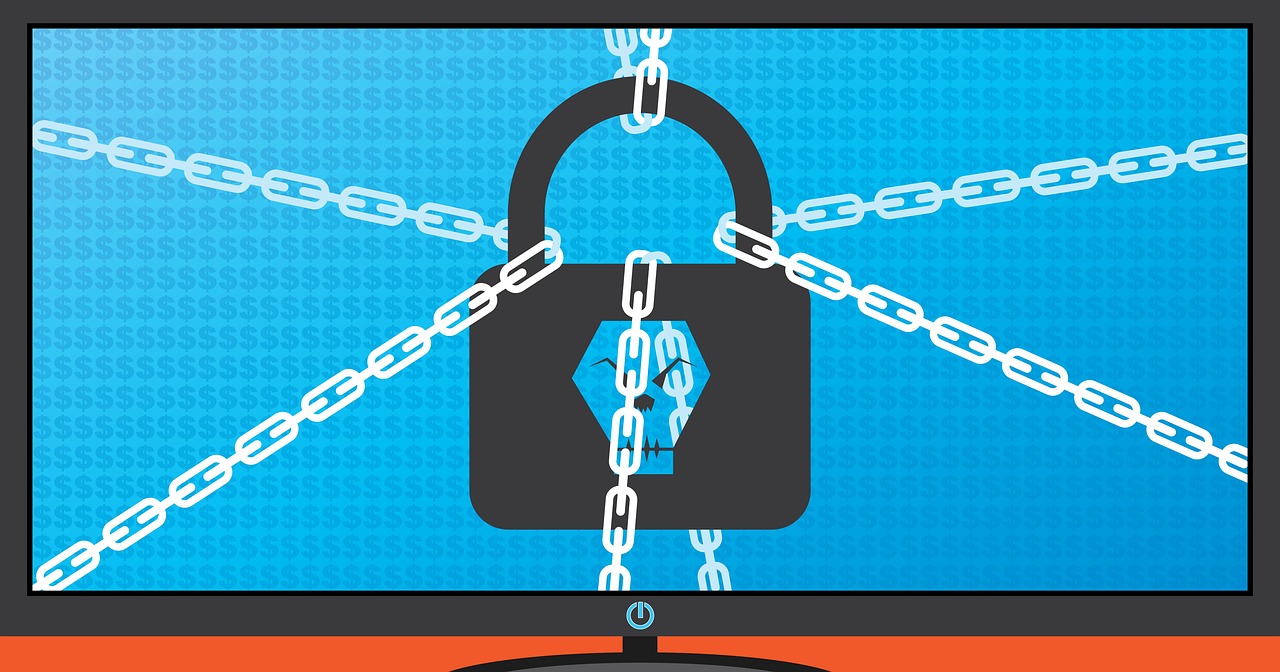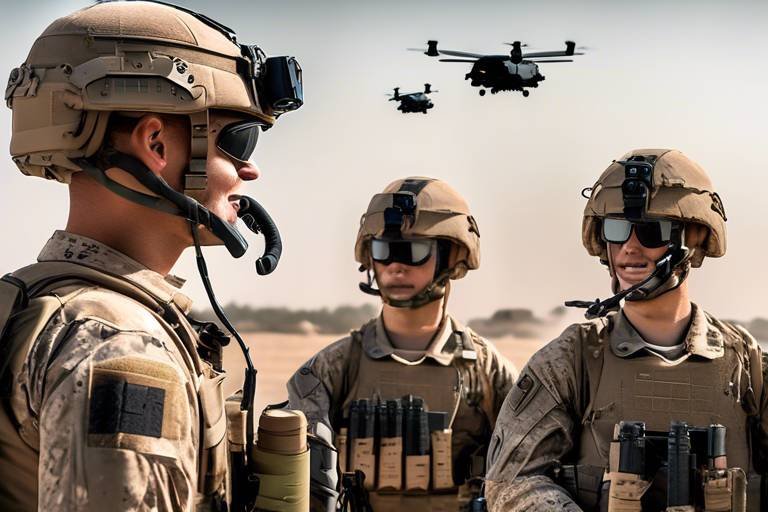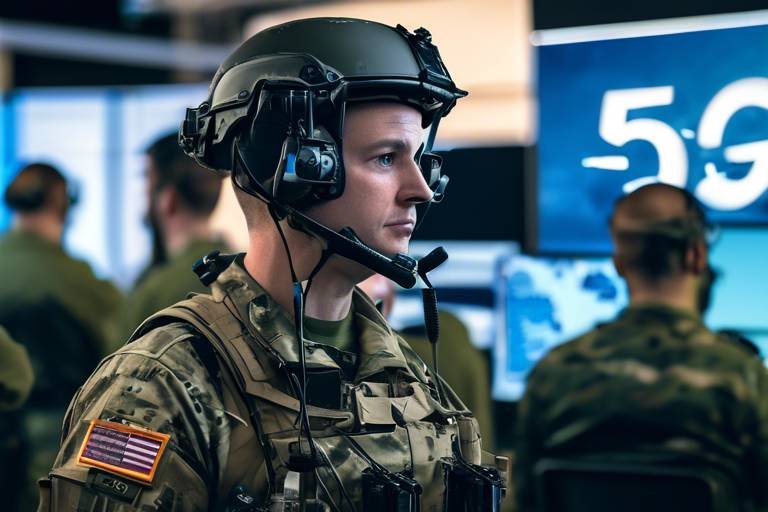Cybersecurity Threats to Military Networks and How to Combat Them
This article explores the various cybersecurity threats facing military networks and offers insights into effective strategies and technologies to combat these challenges, ensuring national security and operational integrity.
Military networks are not just complex; they are often a patchwork of outdated technologies and modern systems that create a unique set of vulnerabilities. Imagine trying to secure a fortress built over centuries, where some walls are crumbling while others are newly reinforced. This intricate architecture can make it difficult to pinpoint weaknesses, and as a result, military networks can become prime targets for cyber adversaries. The implications of these vulnerabilities are profound, potentially compromising national security and operational integrity. When critical systems are outdated or poorly integrated, they become susceptible to exploitation, which can lead to devastating consequences.
From the shadows of the internet lurk various threats that can jeopardize military operations. These threats range from malware to phishing attacks, each with its unique modus operandi. Understanding these threats is akin to knowing the enemy; it allows military personnel to fortify their defenses. Here are some of the most common types of threats that military networks face:
- Malware: Malicious software designed to disrupt, damage, or gain unauthorized access to computer systems.
- Ransomware: A type of malware that encrypts files and demands payment for their release.
- Phishing: Deceptive attempts to obtain sensitive information by masquerading as a trustworthy entity.
- Insider Threats: Risks that originate from within the organization, whether intentional or accidental.
Malware and ransomware attacks have become increasingly prevalent, posing significant risks to military networks. These attacks can lead to data breaches or operational disruptions that can cripple military readiness. For example, the infamous WannaCry ransomware attack affected organizations worldwide, including some government entities. The key to combating these threats lies in understanding their mechanics and implementing preventive measures. Regular software updates, robust firewall protections, and intrusion detection systems are vital in creating a resilient defense against these malicious attacks.
Insider threats are particularly insidious because they can stem from individuals who have legitimate access to military networks. Whether it's a disgruntled employee or someone who inadvertently clicks on a malicious link, the risks are real and significant. Monitoring and training personnel is essential to mitigate these risks. Just as you wouldn't leave the door to a vault wide open, military organizations must ensure that they have stringent access controls and ongoing training programs to educate staff about potential threats.
The ramifications of cybersecurity breaches can be catastrophic for military operations. Imagine a scenario where a cyberattack compromises communication systems during a critical mission; the consequences could be dire. Such breaches can lead to the loss of sensitive data, operational delays, and a significant erosion of trust in military capabilities. Therefore, understanding the potential impacts of these breaches is crucial for developing effective defense strategies.
Implementing best practices is not just a recommendation; it is essential for protecting military networks. A proactive approach can significantly enhance cybersecurity posture. Key strategies include:
- Regular Software Updates: Keeping software and systems updated is crucial for preventing vulnerabilities.
- Employee Training Programs: Training personnel in cybersecurity awareness is vital to prevent human errors.
- Incident Response Planning: Having a robust plan in place can help organizations respond swiftly to breaches.
Keeping software and systems updated is not just about convenience; it’s about security. Cybercriminals are always on the lookout for unpatched vulnerabilities, and timely updates can close these gaps. Just like a knight sharpening his sword before battle, military networks must prioritize patch management to maintain a strong defense.
Training personnel in cybersecurity awareness is vital to prevent human errors. A well-informed team can recognize and respond to potential threats effectively. Training programs should be engaging and informative, utilizing real-world examples to illustrate the importance of cybersecurity. Think of it as equipping soldiers with the knowledge they need to fight an invisible enemy.
Advancements in technology offer new tools for enhancing military cybersecurity. Innovations such as artificial intelligence and blockchain are paving the way for more robust defenses against evolving cyber threats. AI can analyze vast amounts of data to identify anomalies, while blockchain technology can secure communications and data integrity. Embracing these technologies is not just a trend; it's a necessity in the ever-evolving landscape of cybersecurity.
Collaborating with cybersecurity agencies can significantly strengthen military defenses. Partnerships with government and private sector organizations allow for the sharing of intelligence and resources, creating a more formidable front against cyber threats. Just as allies come together in times of war, military organizations must unite with cybersecurity experts to bolster their defenses and safeguard national security.
Q: What are the most common cybersecurity threats to military networks?
A: The most common threats include malware, ransomware, phishing attacks, and insider threats.
Q: How can military personnel protect themselves from cyber threats?
A: Regular training, awareness programs, and adhering to cybersecurity best practices are essential for protection.
Q: Why is collaboration with cybersecurity agencies important?
A: Collaboration enhances intelligence sharing and resource allocation, making it easier to combat cyber threats effectively.

Understanding Military Network Vulnerabilities
Military networks are the backbone of national defense, but they are not without their vulnerabilities. These vulnerabilities stem from a combination of factors, including the complexity of military architectures and a reliance on outdated technologies. As technology evolves, so too does the landscape of threats, and military networks often lag behind in adopting the latest security measures. This creates a perfect storm for potential cyber-attacks that could compromise national security.
One major vulnerability is the interconnectedness of military systems. While this connectivity allows for enhanced communication and operational efficiency, it also opens multiple entry points for cybercriminals. If one system is breached, it can serve as a gateway to others, leading to a cascade of failures. Imagine a spider web; if you break one strand, the entire web can collapse. Similarly, a single vulnerability can jeopardize the integrity of military operations.
Moreover, many military networks still utilize legacy systems that are not designed to withstand modern cyber threats. These outdated systems often lack the necessary patches and updates, making them easy targets for hackers. The reliance on such technology is akin to using a rusty lock on a high-value safe; it may have worked in the past, but it's simply not secure enough for today's threats.
Another significant vulnerability is the human factor. Personnel working within military networks may inadvertently expose sensitive information through negligence or lack of training. Even the most sophisticated systems can be undermined by a simple mistake, such as clicking on a phishing link or failing to follow security protocols. This underscores the importance of continuous training and awareness programs for military staff, as they are often the first line of defense against cyber threats.
In addition to these factors, military networks are also targeted due to their strategic importance. The information housed within these systems is invaluable, not just to enemy states but also to cybercriminals looking to sell sensitive data on the dark web. This makes military networks a prime target, and the consequences of a successful attack can be catastrophic.
To better understand the vulnerabilities facing military networks, let's take a look at a table summarizing the key factors:
| Vulnerability | Description |
|---|---|
| Complex Architectures | Interconnected systems create multiple entry points for attacks. |
| Outdated Technologies | Legacy systems lack modern security features and updates. |
| Human Error | Personnel may inadvertently compromise security through negligence. |
| Strategic Importance | Military networks are prime targets for cybercriminals and enemy states. |
In conclusion, understanding the vulnerabilities of military networks is crucial for developing effective cybersecurity strategies. By recognizing the complex interplay of technology and human factors, military organizations can better prepare themselves to combat the ever-evolving landscape of cyber threats.
- What are the main vulnerabilities in military networks? The main vulnerabilities include complex architectures, outdated technologies, human error, and their strategic importance.
- How can military networks improve their cybersecurity? Implementing regular software updates, conducting employee training, and adopting advanced technologies can significantly enhance cybersecurity.
- Why are military networks targeted by cybercriminals? Military networks hold sensitive information that is valuable to both enemy states and cybercriminals, making them prime targets for attacks.

Types of Cybersecurity Threats
In the ever-evolving landscape of military operations, the threats posed by cybercriminals are not just an afterthought; they are a pressing concern that can compromise national security. Military networks, designed to be robust and secure, are frequently targeted due to their critical role in defense strategies. Understanding the various types of cybersecurity threats is essential for developing effective countermeasures. These threats can be broadly categorized into several types, each with its own characteristics and potential impact.
First on the list are malware attacks, which include a range of malicious software designed to disrupt, damage, or gain unauthorized access to computer systems. Within this category, ransomware has emerged as a particularly alarming threat. Ransomware can lock down critical data, leaving military operations paralyzed until a ransom is paid. The infamous WannaCry attack serves as a stark reminder of how devastating ransomware can be, affecting organizations worldwide, including some military networks. The consequences of such attacks can be catastrophic, leading to not only financial loss but also a significant breach of operational integrity.
Another major category is phishing attacks, which often involve deceptive emails or messages designed to trick personnel into divulging sensitive information. These attacks can be incredibly sophisticated, mimicking trusted sources within the military or government. For example, an email that appears to come from a high-ranking officer requesting sensitive information can easily deceive even the most vigilant personnel. This highlights the need for rigorous training and awareness programs to equip military staff with the skills to recognize and report such attempts.
Moreover, we cannot ignore the threat posed by insider threats. These threats can arise from disgruntled employees or even through unintentional negligence. An insider with access to sensitive information can cause significant damage, whether through malicious intent or simple human error. For instance, an employee might accidentally expose critical data by using unsecured networks or failing to follow established protocols. This underscores the importance of continuous monitoring and comprehensive training to mitigate risks from within the organization.
Additionally, we have the looming threat of Distributed Denial-of-Service (DDoS) attacks. These attacks aim to overwhelm military networks with traffic, rendering them inoperable. Such disruptions can severely impact military readiness and response capabilities. The infamous Mirai botnet attack is a prime example of how DDoS attacks can be orchestrated to disrupt services on a massive scale.
Finally, there’s the danger of advanced persistent threats (APTs). These are prolonged and targeted cyberattacks where an intruder gains access to a network and remains undetected for an extended period. APTs are often state-sponsored and can be used to steal sensitive information or sabotage military operations. The stealthy nature of APTs makes them particularly challenging to detect and combat, requiring advanced monitoring and threat detection technologies.
In summary, military networks face a diverse array of cybersecurity threats, each with its own unique challenges. From malware and phishing to insider threats and DDoS attacks, the landscape is fraught with dangers that can undermine national security. Understanding these threats is the first step in developing robust strategies to combat them and protect our military infrastructure.
- What is the most common type of cyber threat to military networks?
Malware, including ransomware, is one of the most common threats due to its ability to disrupt operations and steal sensitive data. - How can military personnel protect themselves from phishing attacks?
Training and awareness programs are essential. Personnel should be educated on recognizing suspicious emails and the importance of verifying requests for sensitive information. - What steps can be taken to mitigate insider threats?
Implementing strict access controls, continuous monitoring, and regular training can help reduce the risk of insider threats.

Malware and Ransomware Attacks
In the realm of cybersecurity, malware and ransomware attacks stand out as some of the most alarming threats to military networks. These malicious programs are designed to infiltrate systems, disrupt operations, and compromise sensitive data. Imagine a soldier on the battlefield, only to find that their communication systems are suddenly incapacitated by a cyber attack; this is the harsh reality that military personnel face when dealing with these threats.
Malware, short for malicious software, encompasses a variety of harmful programs, including viruses, worms, and Trojans. Each type has its unique method of attack and can lead to severe consequences. For instance, a virus might replicate itself and spread to other systems, while a Trojan may masquerade as legitimate software to gain access to secure networks. The complexity of military networks makes them prime targets for such attacks, as they often rely on outdated systems that lack modern security measures.
On the other hand, ransomware takes the threat to a whole new level. This type of malware locks users out of their systems and demands payment for the decryption key. The infamous WannaCry attack in 2017 is a notable example, where critical services were paralyzed worldwide, including healthcare systems. For military networks, the implications of a successful ransomware attack could be catastrophic, potentially compromising national security and operational integrity.
To combat these insidious threats, military organizations must adopt a multifaceted approach. Here are some key preventive measures:
- Regular Security Audits: Conducting routine assessments of network security can help identify vulnerabilities before they are exploited.
- Advanced Threat Detection: Implementing AI-driven detection systems can enhance the ability to identify and neutralize threats in real-time.
- Incident Response Plans: Developing and regularly updating response plans ensures that military personnel are prepared to act swiftly in the event of an attack.
The stakes are incredibly high when it comes to malware and ransomware attacks on military networks. Not only do these threats endanger operational capabilities, but they also pose a risk to sensitive information that could be exploited by adversaries. Therefore, staying informed and prepared is not just advisable; it's essential for maintaining national security.
Q1: What is the difference between malware and ransomware?
A1: Malware is a broad term that refers to any malicious software designed to harm or exploit devices, while ransomware specifically locks users out of their systems until a ransom is paid.
Q2: How can military networks protect themselves from ransomware attacks?
A2: Implementing strong security measures, conducting regular training for personnel, and maintaining updated software are crucial steps in protecting against ransomware.
Q3: What should be included in an incident response plan?
A3: An effective incident response plan should outline roles and responsibilities, communication protocols, and procedures for containment, eradication, and recovery from cyber incidents.

Insider Threats
When we think about cybersecurity threats, our minds often jump to external hackers lurking in the shadows, ready to pounce on unsuspecting military networks. However, one of the most insidious threats comes from within—insider threats. These threats can arise from disgruntled employees, contractors, or even well-meaning staff who unintentionally compromise security protocols. Imagine a trusted soldier who, out of frustration or negligence, opens a door to cyber vulnerabilities; it’s a scenario that can have catastrophic consequences.
Insider threats are particularly dangerous because they exploit the inherent trust placed in personnel. Unlike external attacks, which can often be detected by firewalls and intrusion detection systems, insider threats can be much harder to spot. They operate under the radar, often using legitimate access to sensitive information and systems. This makes it crucial for military organizations to implement stringent monitoring and access controls to mitigate these risks.
There are two primary types of insider threats: malicious insiders and negligent insiders. Malicious insiders are those who intentionally seek to harm the organization, whether for personal gain, revenge, or ideological reasons. On the other hand, negligent insiders may not have malicious intent but can still cause significant damage through careless actions, such as failing to follow security protocols or falling victim to phishing scams. The table below summarizes the key differences between these two types of insider threats:
| Type of Insider Threat | Description | Examples |
|---|---|---|
| Malicious Insiders | Individuals who intentionally exploit their access for harmful purposes. | Data theft, sabotage, espionage |
| Negligent Insiders | Individuals who unintentionally compromise security through careless behavior. | Falling for phishing scams, sharing passwords |
To combat insider threats, military organizations must prioritize comprehensive training programs that emphasize the importance of cybersecurity awareness. Employees should be educated on recognizing potential threats and understanding the implications of their actions. Regular training sessions can help cultivate a culture of security, where everyone feels responsible for protecting sensitive information. Additionally, implementing robust monitoring systems can provide real-time insights into user behavior, allowing organizations to detect unusual activities before they escalate into serious breaches.
Moreover, establishing clear protocols for reporting suspicious behavior can empower personnel to act quickly. When employees know that they can report concerns without fear of retribution, it fosters an environment of vigilance and accountability. In a world where the stakes are incredibly high, investing in a proactive approach to insider threats is not just a smart move—it's a necessity for maintaining national security and operational integrity.
In conclusion, while external threats will always be a concern, the risks posed by insiders cannot be overlooked. By understanding the nature of insider threats and implementing effective strategies to mitigate them, military networks can bolster their defenses and ensure a safer operational environment.
- What are insider threats? Insider threats refer to risks posed by individuals within an organization who have legitimate access to systems and data but may misuse that access.
- How can organizations detect insider threats? Organizations can detect insider threats by implementing monitoring systems, conducting regular audits, and promoting a culture of cybersecurity awareness.
- What are the consequences of insider threats? Insider threats can lead to data breaches, operational disruptions, and significant financial losses, impacting national security and organizational integrity.
- How can employee training help prevent insider threats? Employee training can educate staff on recognizing potential threats and understanding the importance of following security protocols, reducing the likelihood of negligent actions.

Impact of Cybersecurity Breaches
The ramifications of cybersecurity breaches on military networks are not just technical issues; they can lead to severe national security threats and operational failures. Imagine a scenario where sensitive military data is compromised or, even worse, operational systems are brought down. The implications can be catastrophic, affecting everything from troop movements to strategic decision-making.
One of the most alarming impacts of a successful cyber attack is the potential for data breaches. Sensitive information, including troop locations, mission plans, and classified communications, can be exposed. This not only puts military personnel at risk but also jeopardizes national security. The fallout from such breaches can lead to loss of trust in military institutions and can significantly compromise the effectiveness of military operations.
Moreover, the operational integrity of military networks can be severely disrupted. Cyber attacks can lead to system outages, rendering critical communication and command systems inoperable. This disruption can delay responses to emerging threats and hinder the military's ability to carry out its missions effectively. The chaos created by such breaches can also lead to confusion among ranks, ultimately affecting morale and operational cohesion.
Furthermore, the financial costs associated with recovering from a cybersecurity breach can be staggering. Military organizations may face expenditures related to:
- Incident response and recovery efforts
- Legal fees and potential settlements
- Increased insurance premiums
- Investments in new security technologies
These financial implications can divert funds away from essential military programs and resources, impacting overall readiness and capability. Additionally, the reputational damage to military organizations can lead to a loss of public confidence, further complicating funding and support for future initiatives.
In summary, the impact of cybersecurity breaches on military networks is profound and multifaceted. The potential for data loss, operational disruptions, financial burdens, and reputational damage underscores the urgent need for robust cybersecurity measures. As military networks continue to evolve with technology, the importance of safeguarding these systems against cyber threats cannot be overstated.
- What are the primary causes of cybersecurity breaches in military networks?
Cybersecurity breaches can be caused by a variety of factors, including outdated technology, human error, and sophisticated attacks from external adversaries. - How can military organizations mitigate the risks of cyber attacks?
Implementing regular software updates, conducting employee training programs, and establishing incident response plans are essential strategies for mitigating risks. - What role does collaboration with cybersecurity agencies play in enhancing military security?
Collaboration with cybersecurity agencies allows for the sharing of intelligence and resources, improving overall security posture and response capabilities.

Best Practices for Cyber Defense
In the ever-evolving landscape of cybersecurity, especially within military networks, implementing best practices is not just beneficial; it's essential. The stakes are incredibly high, and a single breach can compromise national security, operational integrity, and even the safety of personnel. So, what can military organizations do to bolster their defenses? Here are some key strategies that can significantly enhance cybersecurity posture.
First and foremost, regular software updates cannot be overstated. Keeping systems and applications up to date is crucial for mitigating vulnerabilities. Cyber adversaries are constantly on the lookout for outdated software that can be exploited. By implementing a robust patch management policy, military networks can close these gaps before they are targeted. For instance, organizations should establish a routine schedule for updates, ensuring that all systems are patched in a timely manner. This proactive approach can drastically reduce the risk of a successful cyber attack.
Equally important is the need for employee training programs. Human error remains one of the most significant vulnerabilities in cybersecurity. Therefore, training personnel to recognize potential threats is vital. Effective training programs should cover a range of topics, from identifying phishing attempts to understanding the importance of password management. Regular workshops and simulations can also keep cybersecurity awareness fresh in the minds of employees. Imagine a soldier trained to detect an enemy ambush; similarly, well-trained personnel can spot cyber threats before they escalate.
Another best practice involves developing a comprehensive incident response plan. This plan outlines the steps to take in the event of a cybersecurity incident, ensuring that all personnel know their roles and responsibilities. A well-defined incident response plan can minimize confusion and expedite recovery efforts, ultimately reducing the impact of a breach. It's akin to having a battle plan; without it, chaos can ensue when an attack occurs.
Additionally, military networks should consider the incorporation of multi-factor authentication (MFA). This added layer of security requires users to provide two or more verification factors to gain access to a system, making it significantly harder for unauthorized users to breach the network. With the rise of sophisticated cyber threats, MFA serves as a formidable barrier against potential intrusions.
Finally, establishing a culture of cybersecurity within the organization is crucial. This means fostering an environment where every individual understands their role in maintaining network security. Regular communication about cybersecurity threats, updates on best practices, and encouraging personnel to report suspicious activities can create a vigilant workforce. Think of it as a team of sentinels, each one aware of their duty to protect the perimeter.
In conclusion, while the challenges posed by cybersecurity threats to military networks are daunting, implementing these best practices can significantly enhance defenses. By prioritizing regular updates, comprehensive training, effective incident response planning, multi-factor authentication, and fostering a culture of cybersecurity, military organizations can better protect themselves against malicious attacks. The goal is not just to respond to threats but to anticipate and neutralize them before they can cause harm.
- What are the most common cybersecurity threats faced by military networks?
Military networks often face threats like malware, ransomware, phishing attacks, and insider threats. - How often should software updates be performed?
Software updates should be performed regularly, ideally on a scheduled basis, to ensure vulnerabilities are patched promptly. - Why is employee training important in cybersecurity?
Employee training helps prevent human errors that can lead to security breaches. Educated personnel are better equipped to recognize and respond to threats. - What is multi-factor authentication, and why is it important?
Multi-factor authentication adds an extra layer of security by requiring multiple forms of verification before granting access, making unauthorized access significantly harder.

Regular Software Updates
In the realm of cybersecurity, the phrase "an ounce of prevention is worth a pound of cure" rings particularly true, especially when it comes to military networks. Regular software updates are not just a best practice; they are a critical line of defense against cyber threats. Think of software updates as the armor that protects a knight in battle. Without this armor, vulnerabilities can be exploited, leading to disastrous consequences. Military networks, which often rely on a complex tapestry of systems and technologies, can become prime targets for cybercriminals if they are not consistently updated.
Many military systems are built on legacy technologies, which can be like trying to defend a castle with crumbling walls. These outdated systems are often riddled with security flaws that hackers can easily exploit. For example, a failure to update a simple piece of software could allow malware to infiltrate the network, causing operational disruptions or data breaches that could compromise national security. The importance of timely updates cannot be overstated; they are essential for patching vulnerabilities and ensuring that the network remains resilient against attacks.
Moreover, the process of updating software is not merely about installing patches; it involves a strategic approach to managing the entire software lifecycle. This includes:
- Conducting regular assessments of software vulnerabilities
- Implementing a robust patch management policy
- Testing updates in a controlled environment before widespread deployment
By adhering to these practices, military organizations can significantly reduce their risk profile. The integration of automated update systems can also streamline this process, ensuring that critical updates are applied without delay. However, it's crucial to remember that automation should never replace human oversight. Regular audits and monitoring are necessary to ensure that updates are effectively implemented and that no vulnerabilities slip through the cracks.
In conclusion, regular software updates are more than just routine maintenance; they are a fundamental aspect of a proactive cybersecurity strategy. By prioritizing updates, military networks can fortify their defenses, protect sensitive information, and maintain operational integrity in an increasingly hostile cyber environment. After all, in today's digital age, staying one step ahead of cyber threats is not just an option—it's a necessity.
Q: Why are regular software updates important for military networks?
A: Regular software updates are crucial for patching vulnerabilities, preventing unauthorized access, and ensuring the integrity of military operations.
Q: What are the consequences of failing to update software?
A: Failing to update software can lead to data breaches, operational disruptions, and exploitation of known vulnerabilities by cybercriminals.
Q: How can military organizations ensure timely updates?
A: Implementing a robust patch management policy, utilizing automated update systems, and conducting regular audits can help ensure timely updates.
Q: Are there any risks associated with software updates?
A: While updates are essential, they can introduce new issues if not tested properly. Therefore, updates should always be tested in a controlled environment before full deployment.

Employee Training Programs
In the realm of cybersecurity, one of the most significant assets a military organization can have is a well-informed and vigilant workforce. Employee training programs are not just a checkbox to tick; they are a critical line of defense against cyber threats. Imagine your personnel as the first responders in a digital battlefield, where their awareness and skills can either thwart an attack or allow it to breach the defenses. The stakes are incredibly high, and this is why investing in comprehensive training is essential.
Training programs should be designed to equip military personnel with the knowledge and skills necessary to identify, respond to, and mitigate cyber threats. This includes understanding the various types of cyber threats, such as phishing, social engineering, and insider threats. By engaging employees in realistic scenarios, they can learn how to recognize suspicious activities and respond appropriately. For instance, a simulated phishing attack can be a powerful tool to demonstrate how easily someone might fall victim to such tactics.
Moreover, training should not be a one-time event. Cybersecurity is a rapidly evolving field, and new threats emerge constantly. Therefore, ongoing education is crucial. Regular refresher courses can help keep personnel updated on the latest threats and best practices. This continuous learning approach ensures that employees remain vigilant and prepared. A well-structured training program might include:
- Interactive workshops on identifying phishing emails.
- Simulations of real-world cyber attack scenarios.
- Regular assessments to gauge understanding and readiness.
- Collaboration with cybersecurity experts for guest lectures.
In addition to technical skills, training programs should also emphasize the importance of a strong security culture within the organization. Employees must understand that cybersecurity is not solely the responsibility of the IT department; it is a shared responsibility that requires everyone’s involvement. By fostering a culture where security is prioritized, organizations can create an environment where personnel feel empowered to report suspicious activities without fear of repercussions.
Furthermore, measuring the effectiveness of these training programs is essential. Organizations should implement metrics to assess the success of their training initiatives. This could involve tracking the number of reported phishing attempts, the speed of incident response, or employee feedback on the training material. By analyzing this data, military organizations can continually refine their training programs to better meet their needs.
In conclusion, employee training programs are not just a necessity but a strategic imperative for military networks. By investing in comprehensive and ongoing training, military organizations can enhance their cybersecurity posture significantly. With a well-trained workforce, they can transform potential vulnerabilities into strengths, ensuring that they are always prepared to face the ever-evolving landscape of cyber threats.
- What are the key components of an effective employee training program?
An effective program should include interactive workshops, regular assessments, and a focus on creating a strong security culture. - How often should training be conducted?
Training should be ongoing, with regular refresher courses and updates to keep personnel informed about the latest threats. - Can simulations really help in training?
Yes, simulations provide hands-on experience and help employees learn how to respond to real-world cyber threats effectively. - What metrics can be used to measure training effectiveness?
Metrics may include the number of reported incidents, response times, and employee feedback on training content.

Emerging Technologies in Cybersecurity
In the ever-evolving landscape of cybersecurity, emerging technologies are becoming a beacon of hope for military networks facing sophisticated cyber threats. As adversaries continuously enhance their tactics, the military must leverage cutting-edge innovations to stay one step ahead. One of the most promising advancements is the integration of artificial intelligence (AI) into cybersecurity protocols. AI can analyze vast amounts of data at lightning speed, identifying patterns and anomalies that human analysts might overlook. This capability not only improves threat detection but also enables proactive measures, allowing military networks to respond to potential breaches before they escalate.
Another game-changing technology is blockchain. Originally designed for cryptocurrency, blockchain's decentralized nature offers robust security features that are particularly beneficial for military operations. By ensuring data integrity and preventing unauthorized alterations, blockchain can safeguard sensitive information from cyber intrusions. Imagine a military network where every transaction and data exchange is recorded in an immutable ledger—this could drastically reduce the risk of data tampering and enhance overall operational security.
Moreover, the rise of quantum computing is set to revolutionize cybersecurity. While still in its infancy, quantum computing promises unprecedented processing power, which could lead to the development of encryption methods that are virtually unbreakable. This means that military communications could become significantly more secure, making it incredibly difficult for adversaries to intercept or decipher sensitive information.
To give you a clearer picture of how these technologies stack up, here’s a brief comparison:
| Technology | Benefits | Challenges |
|---|---|---|
| Artificial Intelligence | Fast data analysis, proactive threat detection | High implementation costs, potential for false positives |
| Blockchain | Data integrity, decentralized security | Scalability issues, complexity of integration |
| Quantum Computing | Unbreakable encryption, enhanced processing power | Still experimental, requires specialized knowledge |
Additionally, the military must not overlook the importance of cloud computing in cybersecurity. By utilizing secure cloud platforms, military networks can enhance their data storage and processing capabilities while ensuring that sensitive information is protected by state-of-the-art security measures. Cloud services often come with advanced security features, such as encryption and continuous monitoring, which can significantly bolster a military organization’s defense mechanisms.
Finally, the collaboration between military and private sector entities in developing these technologies is crucial. By pooling resources and expertise, both sectors can create comprehensive cybersecurity solutions that address the unique challenges faced by military networks. As we continue to explore the potential of these emerging technologies, it’s clear that innovation will play a pivotal role in maintaining national security in the face of evolving cyber threats.
- What role does AI play in military cybersecurity? AI enhances threat detection and response times by analyzing data patterns more efficiently than human analysts.
- How can blockchain improve military network security? Blockchain offers immutable records that enhance data integrity and prevent unauthorized alterations.
- What are the potential benefits of quantum computing for cybersecurity? Quantum computing could lead to unbreakable encryption methods, making military communications significantly more secure.
- Why is collaboration important in developing cybersecurity technologies? Collaboration allows for the sharing of resources and expertise, leading to more effective solutions tailored to military needs.

Collaboration with Cybersecurity Agencies
In today's rapidly evolving digital landscape, the need for robust cybersecurity measures has never been more critical, especially for military networks. One of the most effective ways to enhance these defenses is through . By partnering with various governmental and private sector organizations, military networks can benefit from shared intelligence, advanced technologies, and comprehensive strategies that bolster their security posture against emerging threats.
Collaboration can take many forms, from information sharing agreements to joint training exercises. For instance, military organizations can work alongside agencies like the Cybersecurity and Infrastructure Security Agency (CISA) and the National Security Agency (NSA) to stay updated on the latest threat intelligence and vulnerabilities. This exchange of information is crucial; it allows military personnel to anticipate potential attacks and respond proactively rather than reactively. Moreover, by engaging with private cybersecurity firms, the military can access cutting-edge technologies and innovative solutions that may not be available in-house.
Furthermore, collaborative efforts extend beyond mere information sharing. They also encompass joint initiatives aimed at improving overall cybersecurity resilience. For instance, regular workshops and training sessions can be organized, bringing together military personnel and cybersecurity experts to enhance skills and knowledge. These programs can focus on various aspects of cybersecurity, including threat detection, incident response, and the implementation of best practices. The outcome is a more prepared and informed workforce capable of tackling the complex challenges posed by cyber threats.
To illustrate the potential benefits of collaboration, consider the following table that outlines key advantages:
| Advantage | Description |
|---|---|
| Enhanced Threat Intelligence | Access to real-time data on emerging threats and vulnerabilities from various sources. |
| Resource Sharing | Pooling resources for technology, training, and incident response capabilities. |
| Improved Incident Response | Joint exercises and drills to prepare for potential cyber incidents effectively. |
| Increased Awareness | Enhanced understanding of the cyber landscape through shared knowledge and experiences. |
Ultimately, the collaboration between military networks and cybersecurity agencies is not just beneficial; it is essential for safeguarding national security. As cyber threats continue to evolve and become more sophisticated, military organizations must adapt by leveraging the expertise and resources of their partners. This proactive approach not only strengthens defenses but also fosters a culture of cybersecurity awareness and resilience within military ranks.
- Why is collaboration with cybersecurity agencies important for military networks? Collaboration enhances threat intelligence and resource sharing, which are crucial for effective cybersecurity.
- What types of agencies should military networks collaborate with? Military networks should collaborate with both governmental agencies like CISA and NSA, as well as private cybersecurity firms.
- How can joint training exercises benefit military personnel? Joint training exercises improve skills in threat detection and incident response, preparing personnel for real-world challenges.
- What are some examples of collaboration initiatives? Examples include information sharing agreements, joint training sessions, and collaborative incident response planning.
Frequently Asked Questions
- What are the main cybersecurity threats to military networks?
Military networks face a variety of cybersecurity threats, including malware, ransomware, phishing attacks, and insider threats. Each of these poses significant risks to operational integrity and national security, making it crucial to understand their implications and how to combat them.
- How do malware and ransomware attacks affect military operations?
Malware and ransomware can lead to severe data breaches, operational disruptions, and loss of sensitive information. These attacks can cripple military operations, making timely detection and response essential to minimize their impact.
- What role do insider threats play in cybersecurity?
Insider threats can emerge from employees who may intentionally or unintentionally compromise security. This highlights the importance of continuous monitoring and comprehensive training programs to mitigate risks from within the organization.
- What are the consequences of cybersecurity breaches on military networks?
Cybersecurity breaches can have devastating effects, including loss of critical data, compromised missions, and diminished trust in military capabilities. The ramifications can extend beyond immediate operational challenges to long-term national security risks.
- What best practices should be implemented to enhance military cybersecurity?
Key best practices include regular software updates, employee training programs, and incident response planning. These strategies collectively strengthen the cybersecurity posture and help in defending against evolving threats.
- Why are regular software updates important?
Keeping software and systems updated is crucial because it addresses known vulnerabilities. Timely updates and patch management help in preventing potential exploits that could be used by cyber attackers.
- How can employee training programs improve cybersecurity?
Effective training programs equip military personnel with the knowledge to recognize and respond to potential cyber threats. By fostering a culture of cybersecurity awareness, organizations can significantly reduce the risk of human errors leading to breaches.
- What emerging technologies are being used in military cybersecurity?
Innovative technologies like artificial intelligence and blockchain are being explored to enhance military cybersecurity. These tools offer advanced capabilities for threat detection, data integrity, and secure communications.
- How does collaboration with cybersecurity agencies benefit military networks?
Collaboration with cybersecurity agencies enhances military defenses by facilitating the sharing of intelligence and resources. Partnerships with government and private sectors improve security measures and foster a more robust defense against cyber threats.



















